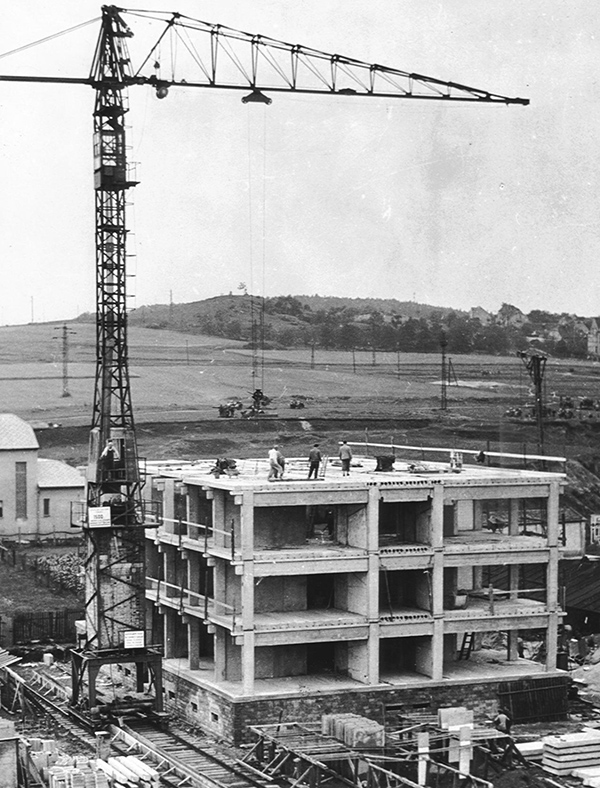
The first Prague panel building does not resemble later panel construction much
 |
The experimental panel building with three floors and a gable roof on U Prefy 771, built in 1953, has pleasantly human dimensions. A new construction system was designed for the house, called a skeletal panel, authored by Miloslav Wimmer. The project was submitted in 1948 and used the so-called T16 type, which allowed for more generous interior spaces in standardized construction. A number of pioneering construction solutions were applied during the construction. A novelty was also the ornamentally designed surface of the panels, improving their technological properties, which is now hidden under the insulation that the house received 15 years ago.
The construction of the panel house prototype faced obstacles. A counter-assessment by structural engineers claimed that the structure was "on the brink of lability" and that living in a house assembled from individual panels would not be safe. Construction continued only after recognized expert in concrete construction Stanislav Bechyně refuted these opinions and confirmed the original tests proving the high safety of the skeleton. Thus, the house welcomed its tenants in the summer of 1955, with its creator Miloslav Wimmer living there from the very beginning. It offered its residents decent comfort with twelve 3+1 apartments with an area of nearly 100 m². For comparison: a three-room panel apartment from the 1970s measured around 60 m².
The first attempts at panel houses on Czech territory date back to World War II and are associated with the Baťa company, which experimented with prefabricated houses made from large concrete blocks poured directly at the construction site in 1940. During the war, several such experimental duplexes were built. After the nationalization of the company, the development workstation gradually moved to the Institute of Prefabricated Structures in Prague. However, the first house made from solid wall panels was built in Zlín (then Gottwaldov) in 1953 in just four months according to the designs of architects Hynek Adamce and Bohumír Kula and was designated G40 (Gottwaldov 40 apartments). That same year, the construction of panel houses began in other cities of Czechoslovakia, including Prague.
The first Prague panel house had a different construction than the one in Zlín, which did not succeed. The reinforced concrete skeleton was expensive, and there was a lack of capacity and technology for mass production; the skeletons and panels were produced directly at the construction site. They were replaced by types G40 and others, which already utilized constructions made from prefabricated panels. In Prague, the first larger housing estate from these houses was built in Pankrác Na Zelené lišce between 1954 and 1955. Initially, panel houses were adorned with various details, house signs, arched entrances, and mosaics. Such houses also grew in places like Zlín and Ostrov in Karlovy Vary. However, these details soon disappeared within the framework of mass construction.
Panel construction brought a relatively quick solution to the housing crisis in socialist Czechoslovakia, often at the cost of low-quality houses and the resignation to any urban planning solutions, especially in recent decades. Panel houses even flooded the historical centers of some cities; an alarming example is the Central Bohemian town of Benešov. Another case was Most, where the historical center had to make way for coal mining, and an entire panel city emerged in its place. In other instances, standardized panel housing estates created entirely new urban districts, with Prague's Jižní Město and Brno's Bohunice being notable examples.
By 1990, approximately 62,500 panel houses were built on the territory of present-day Czech Republic. More than half of them were constructed in the 1970s, with around 33,000 panel houses built between 1971 and 1980. There are nearly 1.2 million apartments in panel houses, where approximately 28 percent of Czech households live according to sociological survey results from 2023 and 2024. In apartment buildings outside of panel estates, 26 percent of households live, and 46 percent in family houses. The highest percentage of households living in panel houses is found in the Ústí nad Labem Region (44 percent), Prague (43 percent), and the Moravian-Silesian Region (41 percent), while the least is in the Vysočina Region (12 percent).
From a general perspective, housing estates in terms of education or socio-economic status of their residents do not differ significantly from the average (for example, 15 percent of housing estate residents have a university degree, which is one percentage point more than the overall population). The average age is lowered as apartments in panel houses are mostly cheaper than those in brick apartment buildings or new constructions (which applies to both purchase and rent), and they often serve as starter homes for young families. Over the past three decades, panel houses have mostly undergone renovations, including thermal insulation, and the housing estates offer accessible civic amenities.
Some housing estates, however, have transformed into ghettos over time; the two most well-known cases involve northwestern Bohemia. The Most-based Chanov and Litvínov's Janov, located away from the centers of both cities, have become socially excluded areas with all the negative consequences that accompany them. Some panel houses in these estates were so devastated that the city council had them demolished; this affected about a dozen panel houses in Janov and Chanov. Otherwise, however, only a few panel buildings were demolished after 1989, for example in 2011 in Havlíčkův Brod, where a four-story house obstructed the view from the ancient Havlíčkovo náměstí.
The English translation is powered by AI tool. Switch to Czech to view the original text source.
0 comments
add comment











